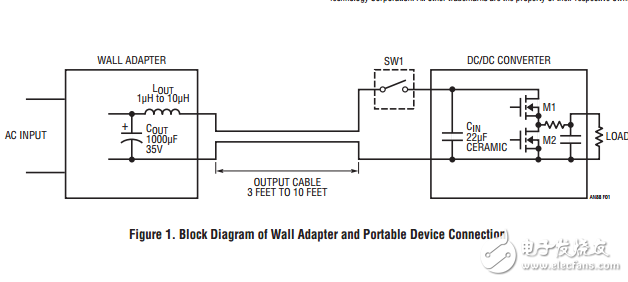
资料下载

陶瓷电容器滤除DC/DC变换器的输入
最近的趋势在便携式设备的设计已经用陶瓷电容器来滤除DC/DC变换器的输入。陶瓷电容器往往选择,因为他们小尺寸,低等效串联电阻(ESR)和高有效电流容量。此外,最近,设计师有一直在寻找陶瓷电容器由于短缺钽电容器。
不幸的是,使用陶瓷电容器输入滤波会引起问题。向陶瓷施加电压台阶电容导致大电流浪涌,存储能量在电感的电源引线。一个大的电压当存储的能量被转移时产生尖峰从这些电感到陶瓷电容器。这些电压尖峰可以很容易的两倍的振幅输入电压阶跃。
插入墙壁适配器在您自己的风险输入电压瞬态问题的能力有关序列。如果墙壁适配器插入交流插座和供电第一,堵墙适配器输出到便携式设备可能会导致输入电压瞬变可能会损坏内部器件DC /直流转换器。

Building the Test Circuit To illustrate the problem, a typical 24V wall adapter used in notebook computer applications was connected to the input of a typical notebook computer DC/DC converter. The DC/DC converter used was a synchronous buck converter that generates 3.3V from a 24V input.
The block diagram of the test setup is shown in Figure 1. The inductor LOUT represents the lumped equivalent inductance of the lead inductance and the output EMI filter inductor found in some wall adapters. The output capacitor in the wall adapter is usually on the order of 1000μF; for our purposes, we can assume that it has low ESR—in the 10mΩ to 30mΩ range. The equivalent circuit of the wall adapter and DC/DC converter interface is actually a series resonant tank, with the dominant components being LOUT, CIN and the lumped ESR (the lumped ESR must include the ESR of CIN, the lead resistance and the resistance of LOUT)。
The input capacitor, CIN, must be a low ESR device, capable of carrying the input ripple current. In a typical notebook computer application, this capacitor is in the range of 10μF
声明:本文内容及配图由入驻作者撰写或者入驻合作网站授权转载。文章观点仅代表作者本人,不代表电子发烧友网立场。文章及其配图仅供工程师学习之用,如有内容侵权或者其他违规问题,请联系本站处理。 举报投诉
- 相关下载
- 相关文章






